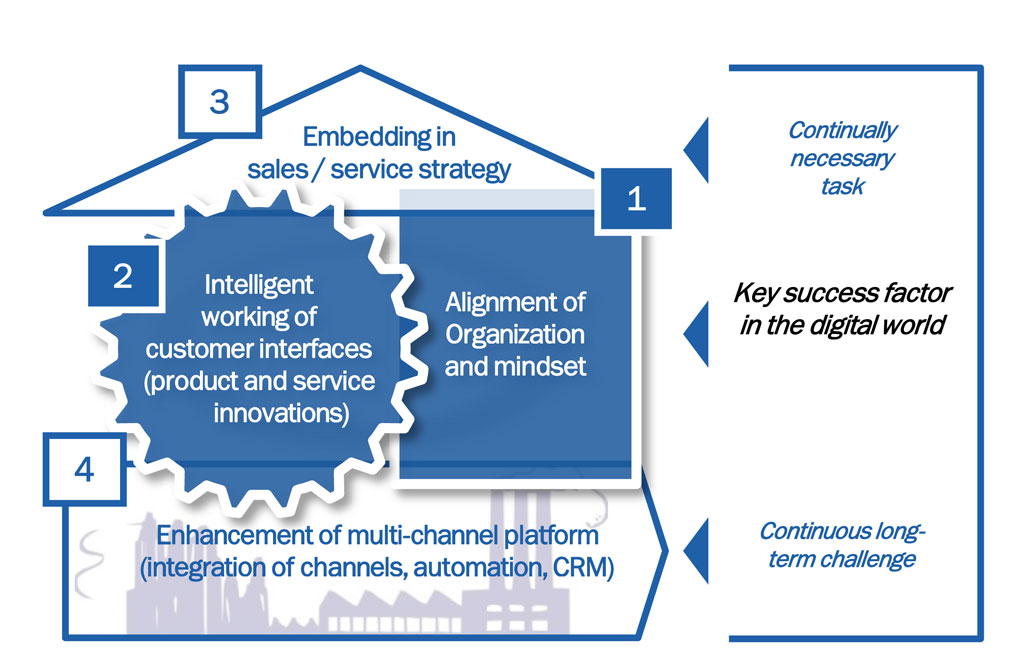The challenge of Digitization
It is already accepted that the Internet has become a part of mainstream society and reaches all social, age and population groups. The fact that the Internet has become mobile—owing to the development of multifunctional smart phones—can hardly be overlooked in public. The answer to the question of which impact this development has on our everyday lives, however, can only be very vaguely guessed for the time being. Mobility and continuous availability of information and interaction options accessible on the Internet increasingly blur the border between the virtual and real worlds, and users develop completely new behavior and response patterns.
The largely unforeseeable but steadily growing possibilities for new contact points, services and business models are both an opportunity and a risk for enterprises. In particular, opportunities include fully repositioning a company with regard to customer relations by consistently focusing on customer needs with the help of new technologies. Risks, of course, lie especially in the fact that already established but also new and, in part, non-industry competitors will succeed in doing so faster and better as well as in a more customer-oriented and more attractive way. As a result, the danger of losing even long-standing customers enters a previously unknown dimension.
Success in the digital world—the modern tetrathlon
Even though a part of the classic barriers to market entry seem to have become less important due to the possibilities offered by digitization, zeb believes that successful positioning in the digital world resembles a modern tetrathlon made up of four disciplines that all have to be tackled:
Discipline 1 — Establishing a digital development team
Innovative ideas as well as a development and roll-out process off the beaten track usually trodden in big corporations require a new way of thinking, decision-making and acting. Therefore, it is recommendable to set up a digital development team outside rigid corporate structures. The digital development team is made up of Internet-savvy “creative minds”, reports directly to the corporation’s board, acts within a defined development budget, maintains a network of innovative development partners in the digital world (technology developers, marketing agencies, etc.), controls the innovation and development process, uses the organization for generating and validating ideas and continuously monitors the success of innovations introduced in the market.
Discipline 2 — Developing product and service innovations
That is the linchpin for success in the digital world. Here the focus is on continuously developing products and services that address customer needs, positively exceed their expectations and are perceived as differentiating and solving problems by the customers. This requires detailed knowledge of the customers, their requirements and, in particular, their current behavior. Moreover, developers have to accept that practical application ultimately determines the success of the new ideas. Therefore, the acid test of practical application has to be taken on an ongoing basis. Development and rollout processes have to use an approach oriented toward trial and error.
Discipline 3 — Integrating into the sales and service strategy
The introduction of new service innovations has to be continuously harmonized with the existing sales and service strategy in order to ensure the seamless integration of diverse services across different sales channels. On the one hand, it is decisive in this context that strategic considerations rather have the nature of development guidelines in order to give creativity sufficient freedom. On the other hand, a flexible integration into existing structures and strategy definitions has to be made possible for new ideas that are successful in the market. As a result, the strategy development process is not as consistently structured from the top down as it traditionally used to be.
Discipline 4 — Further developing the multichannel platform
This is a continuous, long-term and cost-intensive challenge for all companies and covers the process-specific, (data-related) technical and organizational integration of all sales channels. The aim is to provide the customers with a comparable experience of services rendered by the company regardless of the access used and to contact and serve them in line with their personal preferences in a seamless interaction of the individual channels. To take account of rapid technical progress, new service ideas have to be pragmatically connected to the existing channel/IT architecture and, if appropriate, fully integrated only later on. This requires new handling of IT development/release processes.
Conclusion and outlook
In our view, digital change is spreading to further areas of social activities. New business models and, more and more often, disruptive changes open up great opportunities but also harbor major risks for established actors. Previous success in business and experience alone are no longer a guarantee for the successful future of a company.
Digital transformation requires taking new perspectives on processes and markets as well as thinking out of the box. In our experience, stable structures and processes that evolved in the company typically and rather reliably hamstring innovation and change in the disciplines of the “modern tetrathlon” outlined above. Companies who wish to live up to their performance promises also in future have to embrace society’s digital culture and ideally contribute to shaping it actively. It is important to identify the right persons who can serve as role models in the new digital culture within the company itself. By calling in external support, it becomes easier to get a fresh view of well-established structures and processes, to break up habitual thinking patterns and to identify creative minds. It also makes it possible to rethink products and processes and to systematically detect weaknesses in a company’s own system and to change them for the better.

